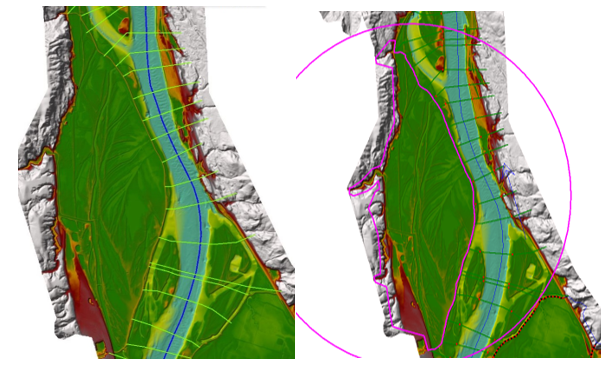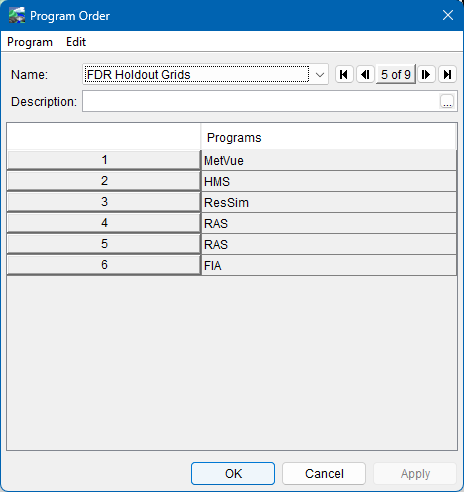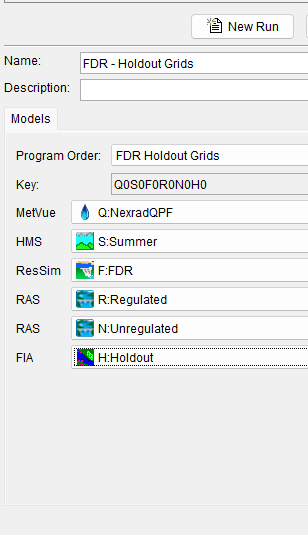HEC-FIA Holdout Grids Compute
Using HEC-FIA to compute holdouts within a single forecast run is the most straightforward and efficient method for calculating FDR. However, it does have limitations and assumptions that make it unsuitable for some watersheds. This method works best for watersheds that contain only reservoirs or those with small levee systems.
Limitations to Keep In Mind
There are a few important limitations to consider with this approach:
- Agricultural FDR Not Supported in the Holdout Grids Compute: This method only computes FDR for structures, not for agricultural areas. To calculate FDR for agricultural areas, the RAS Holdout HDF inundation configuration must be used.
- Cross-Watershed Reservoir Damages: If you need to compute damages across watersheds, additional steps are required, which are outlined later on this page.
What Qualifies as a "Small Levee"?
In this context, a "small levee" refers to a levee system with minimal hydraulic impact on mainstem river stages when comparing the with-levee and without-levee scenarios. While these levees do have some hydraulic effects, their impact is so small that it doesn’t significantly alter the floodplain calculations in the broader scope of the FDR analysis. For example, if the hydraulic differences caused by the levee are smaller than the terrain error tolerances used in HEC-RAS and HEC-FIA, the effect on the model is negligible.
For instance, the figure below shows an example of a "small levee" where the floodplain behind the levee is relatively small, and changes in water surface elevation would not significantly alter the flooded area. Additionally, the volume behind the levee is small enough relative to a typical flood event that removing it wouldn't affect river stage levels enough to change damage estimates.
To learn more about determining the best method for modeling a without-levee scenario, see the section on Selecting a Without-Levee Modeling Approach.

Simplifying Assumptions for Levee FDR Computations
For levees, HEC-FIA Holdout Grids use a simplifying assumption in their inundation calculations: if the levee is removed, water surface elevations (WSEs) within the leveed area are assumed to be the same as those along the river centerline. This assumption works well for small levees with minimal impact on river stages but is not appropriate for large levee systems that significantly affect mainstem river stages.
Computing Reservoir FDR with HEC-FIA
For reservoirs, HEC-FIA Holdout Grids use the outputs from two HEC-RAS alternatives: one for regulated conditions (with reservoirs) and one for unregulated conditions (without reservoirs). The difference in damages between these two conditions provides the total FDR for structures not protected by a levee.
If there are multiple reservoirs, HEC-FIA can allocate FDR to each one in two ways:
- Fixed Percentages: You can manually assign a fixed percentage of benefits to each reservoir.
- Dynamic Allocation: Alternatively, HEC-FIA can use HEC-ResSim results to automatically calculate the percentages for each reservoir based on real-world reservoir operations.
Handling Cross-Watershed Reservoir Benefits
When upstream reservoirs benefit downstream watersheds, allocating FDR across multiple watersheds becomes more complex. One way to address this is by creating a new HEC-ResSim-only watershed that combines multiple HEC-ResSim watersheds. This combined model can then compute holdouts for all reservoirs and allocate FDR across watersheds.
For more complex or cross-watershed scenarios, consider using the HEC-FIA Holdout RAS HDF Compute or the HEC-FIA Individual Computes approach, which offer alternative methods for FDR calculation.
Forecast Setup
In this method, only one forecast run is required to compute the FDR results. The model flow for this approach is shown below, where the watershed contains at least one reservoir and may include levees. The first part of the forecast sequence (including HEC-MetVue, HEC-HMS, and HEC-ResSim) is identical to a typical real-time forecast. However, the sequence diverges at HEC-RAS, where two alternatives are required: one for the regulated condition and one for the unregulated condition.
The results from these two HEC-RAS alternatives are passed to the HEC-FIA Holdouts alternative to calculate the FDR.

Model Alternatives Setup
You’ll need at least two additional model alternatives beyond the standard CWMS real-time setup:
- Unregulated HEC-RAS Alternative: This simulates conditions without reservoirs.
- HEC-FIA Holdout Grids Alternative: This new HEC-FIA configuration computes the FDR results for all four scenarios (including without-levee conditions) and processes them into total FDR outcomes.
For more details on setting up these alternatives, refer to the sections on HEC-RAS Model Setup and HEC-FIA Model Setup.
New Program Order
Since this approach requires two HEC-RAS alternatives, you’ll need to create a new Program Order. You can do this from the Setup tab under Models > Program Order.

New Forecast Run
After setting up the new Program Order, create a new Forecast Run to compute the FDR using this new program order. Additional setup steps, including alternative keys, model linking, and other configurations, are required to ensure the forecast run works properly. The figure below provides an example of how to set up the forecast run within the CAVI.
